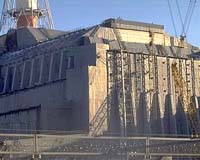| . |  |
. |
Washington (AFP) April 2, 2011 US engineers studying Japan's experience with its crippled nuclear plant have focused on two key weaknesses -- backup energy systems and spent fuel rod pools -- that could also plague reactors in the United States. The Fukushima Daiichi complex largely withstood the massive 9.0-magnitude earthquake on March 11, but was damaged by the giant tsunami wave that following the quake. The twin disasters knocked out the plant's reactor cooling systems, sparking a series of explosions and fires. Authorities have since struggled to keep the fuel rods under water inside reactors and storage containment pools. If they are exposed to air, they could degrade further and emit large amounts of dangerous radioactive material. Two of the plant's six spent fuel rod pools were apparently damaged following the quake and tsunami, said Gregory Jaczko, head of the US Nuclear Regulatory Commission (NRC). "It was possible there was a leak," he told a US Senate hearing on March 30, soon after he returned from Japan. US observers fear the fuel storage containment pools, located on an upper part of the reactor buildings at Fukushima, were cracked by explosions after the quake and tsunami and are leaking. Jaczko said that in the United States, such pools are "robust structures equipped to withstand natural disasters like an earthquake and tsunami," strong enough to safely store nuclear waste for at least a century. But he nevertheless ordered a 90-day review of the Fukushima disaster, which would go far to help assess the safety status at the spent fuel pools at 104 US reactors. The US nuclear energy industry has come under the microscope in the wake of Japan's disaster, with critics pointing to inadequate emergency plans and recent violations at US nuclear plants. David Lochbaum, an expert at the independent Union of Concerned Scientists, worried that tens of thousands of tons of irradiated fuel currently sit in spent pools across the country "with almost no protection." Unlike the reactors, the spent fuel pools are not cooled by a multitude of redundant systems that can be kept running with multiple power backup systems, such as long-lasting batteries, in case the main power goes out -- which is what happened in Japan. Also unlike reactors, which are encased in steel armor and thick concrete, the pools "are often housed in buildings with sheet metal siding" like that used for a storage shed, Lochbaum told the Senate panel. Reducing the amount of irradiated fuel in spent fuel pools "would significantly reduce the safety and security risks from a nuclear power plant," he said. "We have utterly failed to properly manage the risk from irradiated fuel stored at our nation's nuclear plants. We can and must do better," said Lochbaum. Ernest Moniz, a physics professor at the Massachusetts Institute of Technology (MIT), said at the same hearing that a move from pools to safer dry casks "is essential." "The Fukushima problems with spent fuel pools co-located with the reactors will undoubtedly lead to a reevaluation of spent nuclear fuel management strategy" in the United States, he said. US Senator Dianne Feinstein of California worried that spent fuel removed from reactors in 1984 are being stored in an earthquake-prone area of her state, and were still being kept in cooling pools. "Fuel removed from reactors in 1984 is still cooling in wet spent fuel pools" in California, said Feinstein, wondering why the NRC "has not mandated a more rapid transfer of spent fuel to dry casks." With dry casks, the spent fuel rods are sealed inside concrete and steel canisters. "It's clear that we lack a comprehensive national policy to address the nuclear fuel cycle, including management of nuclear waste," she said. Lochbaum also said that the emergency backup batteries at US nuclear power plants are not designed to endure a long power outage. He said that batteries in 93 of the 104 US nuclear reactors can power the plants for four hours, just half the time than the backup batteries at Fukushima, which was clearly not long enough. Anthony Pietrangelo with the Nuclear Energy Institute, which represents the nuclear power industry, told the Senate that designers must consider batteries that last for "at least 48 hours and up to 72 hours."
Share This Article With Planet Earth
Related Links Bringing Order To A World Of Disasters A world of storm and tempest When the Earth Quakes
 Fukushima 'much bigger than Chernobyl': expert
Fukushima 'much bigger than Chernobyl': expertWashington (AFP) April 1, 2011 Japan's unfolding nuclear disaster is "much bigger than Chernobyl" and could rewrite the international scale used to measure the severity of atomic accidents, a Russian expert said here Friday. "Chernobyl was a dirty bomb explosion. The next dirty bomb is Fukushima and it will cost much more" in economic and human terms, said Natalia Mironova, a thermodynamic engineer who became a leading an ... read more |
|
| The content herein, unless otherwise known to be public domain, are Copyright 1995-2010 - SpaceDaily. AFP and UPI Wire Stories are copyright Agence France-Presse and United Press International. ESA Portal Reports are copyright European Space Agency. All NASA sourced material is public domain. Additional copyrights may apply in whole or part to other bona fide parties. Advertising does not imply endorsement,agreement or approval of any opinions, statements or information provided by SpaceDaily on any Web page published or hosted by SpaceDaily. Privacy Statement |